Pilgrimage connects racism to America’s core, focusing Executive Council’s work for changePosted Oct 21, 2019 |
|
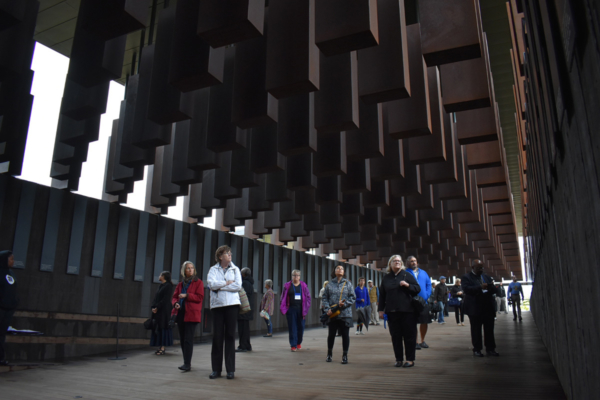
Executive Council members walk slowly through the National Memorial for Peace and Justice in Montgomery, Alabama, on Oct. 19, 2019. Photo: David Paulsen/Episcopal News Service
[Episcopal News Service – Montgomery, Alabama] The Episcopal Church of the Good Shepherd, a small, mostly African American congregation in this city’s Centennial Hill neighborhood, has just eight rows of pews. All of them were filled. Members of The Episcopal Church’s Executive Council were joined by parishioners, all eager to hear from their guest of honor, Bryan Stevenson.
Stevenson, a prominent death row and public interest attorney, is arguably the reason Executive Council chose Montgomery for its fall meeting. His Equal Justice Initiative opened the Legacy Museum and the National Memorial for Peace and Justice last year in Alabama’s capital city to tell the full story of America’s 400-year history of racial violence and terrorism. Those new institutions, as well as Montgomery’s historic ties to the civil rights movement, have turned the city into a popular pilgrimage destination for Episcopalians and others committed to racial reconciliation.
On this afternoon, Stevenson, 59, said he wanted to talk about memory. He began by relating a story from his childhood about feeling the sting of racism growing up black in segregated southern Delaware, but he quickly broadened his point beyond the personal, beyond the regional.
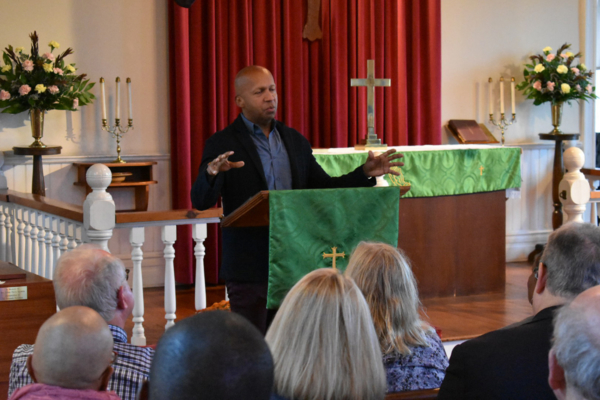
Bryan Stevenson, author of the bestseller “Just Mercy,” speaks to the Executive Council members on Oct. 19, 2019, at Church of the Good Shepherd in Montgomery, Alabama. Photo: David Paulsen/Episcopal News Service
“We’ve actually made it very easy in this country to forget our history of racial injustice,” Stevenson said, and yet the nation is still burdened by that history, by false narratives that have long gone unexamined and that continue to perpetuate racist systems. “I don’t think slavery ended in 1865. It just evolved.”
Stevenson’s afternoon presentation at Good Shepherd capped Executive Council’s daylong pilgrimage Oct. 19, which featured visits to the Equal Justice Initiative’s museum and memorial. With Montgomery as the backdrop of Executive Council’s four-day fall meeting, racial reconciliation is a core theme.
Executive Council took up that theme from the start. Morning Prayer on its opening day, Oct. 18, included the church’s Litany of Repentance and its acknowledgement that the sin of racism “is woven into our lives and our cultures.”
Diane Pollard, in her Morning Prayer homily, noted that she and other members of Executive Council prepared for this meeting in Montgomery by reading Stevenson’s book “Just Mercy” and participating in two webinars. In one, the Rev. Kelly Brown Douglas, dean of Episcopal Divinity School at Union Theological Seminary in New York, spoke of the need for moral leadership in the world. A second webinar featured Catherine Meeks, executive director of the Absalom Jones Center for Racial Healing in the Diocese of Atlanta.
Meeks advised that pilgrimages should be more than mere field trips. “They should be transformative, and we should not return home the way we came,” said Pollard, a lay member from the Diocese of New York.
What should the members bring home with them from their experience learning about the country’s past? “It is my hope that we will bring back with us the memories of not only what happened but the present-day effect it continues to have on our people,” Pollard said during Morning Prayer.
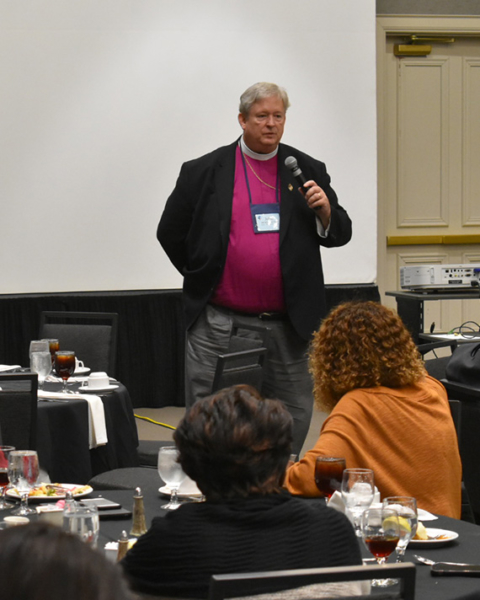
Alabama Bishop Kee Sloan welcomes Executive Council to Montgomery on Oct. 18, 2019, the opening night of the four-day meeting. Photo: David Paulsen/Episcopal News Service
Alabama Bishop Kee Sloan joined Executive Council at dinner on Oct. 18 and offered a brief welcome, as well as a preview of what to expect at the Equal Justice Institute’s museum and memorial.
“In some museums you just walk through and you’re done,” Sloan said. “I hope that you will take some time to let it soak in – what you are seeing and what you are feeling. It is an incredibly evocative experience, and I hope you will take the time to sit with it a while. Don’t mess it up with too many words. Just let it soak in.”
On the morning of the pilgrimage, a hard rain fell as members of Executive Council, several carrying umbrellas, walked the few blocks from the Embassy Suites Montgomery Hotel and Conference Center to the Legacy Museum, which is located on the former site of a slave warehouse and holding pen. Heeding Sloan’s advice, the group spent more than an hour slowly pacing among the museum’s exhibits detailing the brutal inhumanities that, the museum argues, have formed the bitter core of the American experience.
By 1860, 4 million blacks were enslaved in the United States, including nearly 24,000 in Montgomery alone.
“Montgomery, Alabama, was among the most prominent and active slave-trading places in America,” one museum display noted, because of the city’s central location on the Alabama River and a railroad line. There were more slave-trading spaces in the city than there were churches or hotels.
Newspaper ads offering “Negros for Sale” and seeking runaway slaves, “$200 Reward,” are displayed floor to ceiling in the Legacy Museum, and similar displays confront the visitor with examples of continued credence in white supremacy after slavery was abolished. Quotes defending segregation are attributed to a range of prominent white leaders, from governors and senators to a clergy member.
A central premise of the Legacy Museum – as Stevenson reiterated in his speech – is that a false narrative of racial inferiority was used to justify Native genocide and slavery and to ease white Americans’ feelings of guilt, and “that ideology has endured beyond the formal abolition of American slavery,” according to one of the exhibits at the museum.
It endured through the post-Reconstruction rise of lynchings – or, as the Legacy Museum describes them, “racial terror lynchings.” The Equal Justice Initiative has documented more than 4,000 lynchings across 12 Southern states, as well as several hundred more such attacks in other states including in the North, that occurred from 1877 to 1950.
The Equal Justice Initiative also looks beyond that period of violence to portray ways that today’s system of mass incarceration is rooted in the same distorted narrative, with black citizens often perceived unjustly as criminals and punished more frequently and more severely by the criminal justice system than white citizens.
The Episcopal Church, backed by General Convention resolutions, has taken up the cause of ending mass incarceration as part of its racial reconciliation work, and it also has acknowledged its own history of complicity in racist systems. Such faith-based efforts are a crucial part of the push for systemic change, the Legacy Museum suggests in a final display, which prompts visitors to consider how to take action with what they’ve learned.
“Do churches and people of faith have a special obligation to address the history of racial inequality?” the exhibit asks.
At the center of the Episcopal Church’s work on these issues is the Becoming Beloved Community framework, released nearly three years ago to encourage and assist congregations and Episcopalians in engaging in difficult conversations about racism and racial healing. One part of that framework is “telling the truth,” which also is central to the mission of the Equal Justice Initiative’s museum and memorial, said Joe McDaniel, one of three guides during Executive Council’s pilgrimage.
McDaniel, a retired attorney from Pensacola, Florida, serves as co-chair with Gary Moore of the Commission on Racial Justice and Reconciliation in the Diocese of the Central Gulf Coast, which includes the southern portion of Alabama. To lead Executive Council’s pilgrimage, they teamed up with the Rev. Carolyn Foster, a deacon from the Diocese of Alabama and co-chair of that diocese’s racial reconciliation commission.
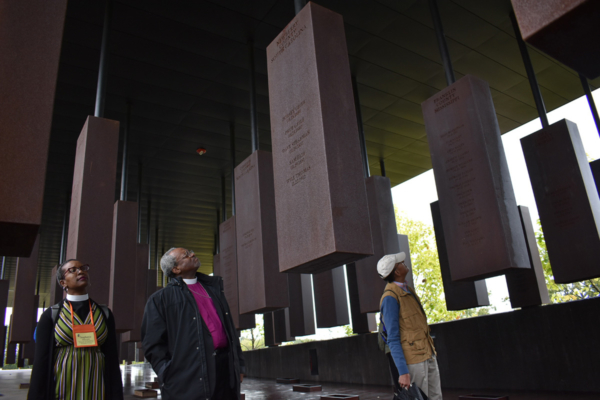
Presiding Bishop Michael Curry on Oct. 19, 2019, looks up at one of the columns hanging at the National Memorial for Peace and Justice in Montgomery, Alabama. The steel columns memorialize the victims of lynching from 1877 to 1950, with each column representing an American county where at least one of the attacks occurred. Photo: David Paulsen/Episcopal News Service
It was McDaniel’s fifth time leading a reconciliation pilgrimage to Montgomery since December 2018. His first visit to the Legacy Museum and the National Memorial for Peace and Justice was in April of that year, around the time the two sites opened, and it proved to be a particularly difficult experience for him.
“It was overwhelming,” McDaniel said. “I actually had to leave early. I broke down in tears, just witnessing man’s inhumanity to each other.”
The memorial is intended to honor all of the more than 4,000 lynching victims in the country, some named and some whose identity is unknown. On a hill overlooking downtown Montgomery, a series of steel columns hang in rows around a green square. Each column represents a county where the Equal Justice Initiative has confirmed at least one lynching occurred. The victims are listed on the columns.
The Executive Council members ascended the hill to the memorial’s starting point. As they began passing between the columns, they were able to examine them at eye level. But as they proceeded, they followed a path downward, so that the columns further along the path were suspended higher and higher overhead – invoking the sight of victims hanging dead.
The Equal Justice Initiative also created duplicate columns for each of the more than 800 counties and laid them on the grounds of the memorial, inviting each county to claim and display its column as an act of confronting, acknowledging and remembering its history. Few counties have done so yet.
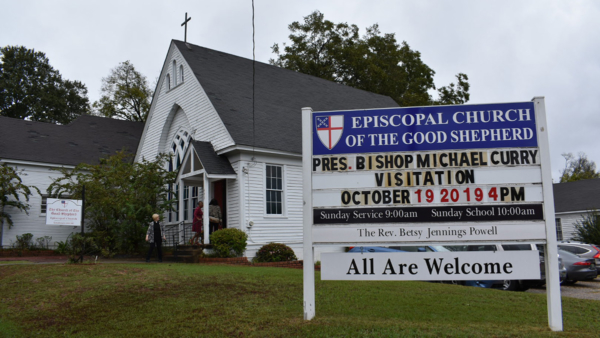
The Episcopal Church of the Good Shepherd is located in Montgomery’s historically black Centennial Hill neighborhood. Photo: David Paulsen/Episcopal News Service
“You can’t have reconciliation until you have truth,” Stevenson told Executive Council members later that day, after they had traveled by bus and van to Good Shepherd. Stevenson also urged them not to lose hope in the face of such injustices.
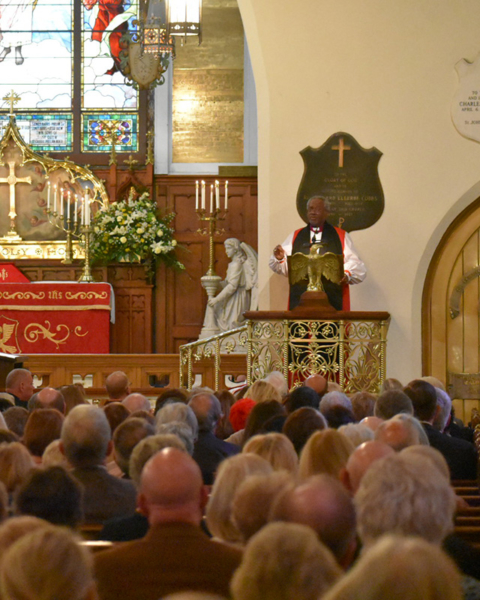
Presiding Bishop Michael Curry preaches Oct. 20, 2019, at St. John’s Episcopal Church in downtown Montgomery, Alabama. Photo: David Paulsen/Episcopal News Service
“Hopelessness is the enemy of justice,” Stevenson said. “Our hope is critical to our capacity to change the world.”
The following morning, on Oct. 20, Presiding Bishop Michael Curry referred to Stevenson’s “words of wisdom and his words of hope for us all” in his sermon during the Eucharist at St. John’s Episcopal Church in downtown Montgomery. A large crowd, easily topping a hundred, had packed the nave of the church.
Curry, as he often does in his sermons, emphasized the theme of God’s love and assured his listeners that Jesus had shown the way of love.
“There is one God who created us all, and if we come from one source, you know what that means – we’re all kinfolk,” Curry said. “We are all the children of God. We can learn to live together. We can learn to build life together. … We can learn to build a new world.”
– David Paulsen is an editor and reporter for Episcopal News Service. He can be reached at dpaulsen@episcopalchurch.org.

Social Menu